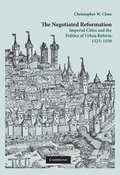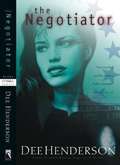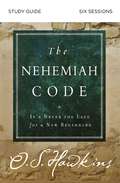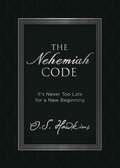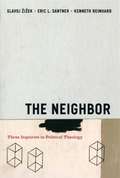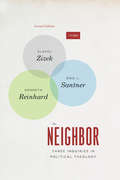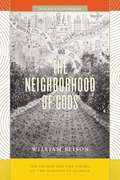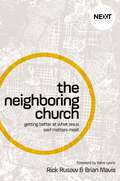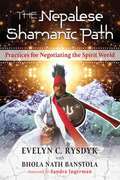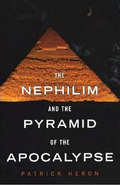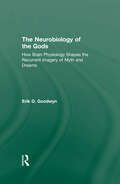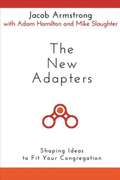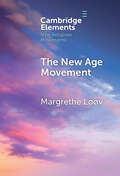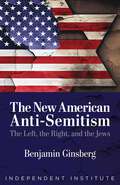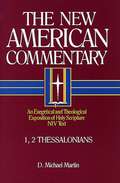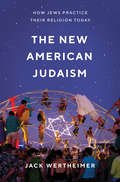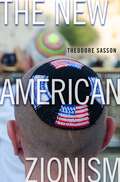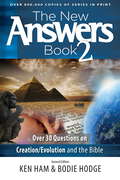- Table View
- List View
The Negotiated Reformation: Imperial Cities and the Politics of Urban Reform, 1525-1550
by Christopher W. CloseUtilizing evidence from numerous imperial cities, this book offers a new explanation for the spread and survival of urban reform during the sixteenth century. By analyzing the operation of regional political constellations, it reveals a common process of negotiation that shaped the Reformation in the Holy Roman Empire. It reevaluates traditional models of reform that leave unexplored the religious implications of flexible systems of communication and support among cities. Such networks influenced urban reform in fundamental ways, affecting how Protestant preachers moved from city to city, as well as what versions of the Reformation city councils introduced. This fusion of religion and politics meant that with local variations, negotiation within a regional framework sat at the heart of urban reform. The Negotiated Reformation therefore explains not only how the Reformation spread to almost every imperial city in southern Germany, but also how it survived imperial attempts to repress religious reform.
The Negotiator (O'Malley Family Series, #1)
by Dee HendersonFollows the story of Kate O'Malley, a hostage negotiator, and the events that will change her family forever.
The Nehemiah Code Bible Study Guide: It's Never Too Late for a New Beginning
by O. S. HawkinsYou can have a new beginning.In this six-session video Bible study (DVD/digital downloads sold separately), O.S. Hawkins, bestselling author of the Code series, draws on the book of Nehemiah to show how each of us can begin again when we look to God for help. Whether we have suffered broken relationships, integrity missteps, devastating loss, or any other setback, it is never too late to rebuild our lives!Nehemiah understood this truth when he called on the Lord for insight during his people&’s hard times. He was an ordinary man who applied principles from God that enabled him to rebuild a broken city wall and, in the process, rebuild a lot of broken hopes. Nehemiah left behind some secrets of his success–a sort of hidden &“code&”–which can become a fountain of hope and strength to us. Nehemiah&’s message across the centuries is plain and powerful: it is never too late for a new beginning!The Nehemiah Code Study Guide includes video teaching notes, discussion questions, Bible exploration, and weekly personal study and reflection materials.Sessions include:Get Started RightBuild a Team SpiritLet Go Without Letting UpPersevere Through DifficultiesNever Cut What Can Be UntiedFinish StrongDesigned for use with The Nehemiah Code Video Study (9780310099901), sold separately.
The Nehemiah Code: It's Never Too Late for a New Beginning (The Code Series)
by O. S. HawkinsWho isn’t in need of a new beginning? Bestselling author O. S. Hawkins knows that whether it be broken relationships, integrity missteps, or loss, most of us will spend some or much of the next year trying to restore something. The good news is . . . it’s never too late for a new beginning.Hawkins, with more than 550,000 books sold, now turns his eye to another biblical hero in The Nehemiah Code. Nehemiah was a civil servant from 2,500 years ago who applied principles found in the Bible for insight during hard times, help to start again, and encouragement to rebuild a life.The Nehemiah Code dives into a theme that will resonate deeply with a wide variety of readers - insight during hard times, help to start again, and encouragement to rebuild a life. Topics include: Taking personal responsibilityMoving out of your comfort zoneRebuilding team spiritHolding those around you accountableDoing what is rightFinishing strongProceeds of the book go directly to the ministry Mission:Dignity, which helps more than 1,800 retired ministers, church workers, and widows who have faithfully served God’s people and now find themselves struggling to meet even basic needs.
The Neighbor
by Debra White SmithDr. Alissa Carrington has just moved into her house in Tyler, Texas. During her vacation from her work as a dentist, she becomes acquainted with her handsome next-door neighbor, Brad Ratnor. But it seems that someone wants Alissa dead!
The Neighbor: Three Inquiries in Political Theology
by Slavoj Zizek Eric L. Santner Kenneth ReinhardIn Civilization and Its Discontents, Freud made abundantly clear what he thought about the biblical injunction, first articulated in Leviticus 19:18 and then elaborated in Christian teachings, to love one's neighbor as oneself. "Let us adopt a naive attitude towards it," he proposed, "as though we were hearing it for the first time; we shall be unable then to suppress a feeling of surprise and bewilderment." In The Neighbor, three of the most significant intellectuals working in psychoanalysis and critical theory collaborate to show how this problem of neighbor-love opens questions that are fundamental to ethical inquiry and that suggest a new theological configuration of political theory.
The Neighbor: Three Inquiries in Political Theology, with a new Preface
by Slavoj Žižek Eric L. Santner Kenneth ReinhardIn Civilization and Its Discontents, Freud made abundantly clear what he thought about the biblical injunction, first articulated in Leviticus 19:18 and then elaborated in Christian teachings, to love one's neighbor as oneself. “Let us adopt a naive attitude towards it,” he proposed, “as though we were hearing it for the first time; we shall be unable then to suppress a feeling of surprise and bewilderment.” After the horrors of World War II, the Holocaust, and Stalinism, Leviticus 19:18 seems even less conceivable—but all the more urgent now—than Freud imagined. In The Neighbor, three of the most significant intellectuals working in psychoanalysis and critical theory collaborate to show how this problem of neighbor-love opens questions that are fundamental to ethical inquiry and that suggest a new theological configuration of political theory. Their three extended essays explore today's central historical problem: the persistence of the theological in the political. In “Toward a Political Theology of the Neighbor,” Kenneth Reinhard supplements Carl Schmitt’s political theology of the enemy and friend with a political theology of the neighbor based in psychoanalysis. In “Miracles Happen,” Eric L. Santner extends the book's exploration of neighbor-love through a bracing reassessment of Benjamin and Rosenzweig. And in an impassioned plea for ethical violence, Slavoj Žižek’s “Neighbors and Other Monsters” reconsiders the idea of excess to rehabilitate a positive sense of the inhuman and challenge the influence of Levinas on contemporary ethical thought. A rich and suggestive account of the interplay between love and hate, self and other, personal and political, The Neighbor has proven to be a touchstone across the humanities and a crucial text for understanding the persistence of political theology in secular modernity. This new edition contains a new preface by the authors.
The Neighborhood of Gods: The Sacred and the Visible at the Margins of Mumbai (South Asia Across the Disciplines)
by William ElisonThere are many holy cities in India, but Mumbai is not usually considered one of them. More popular images of the city capture the world’s collective imagination—as a Bollywood fantasia or a slumland dystopia. Yet for many, if not most, people who live in the city, the neighborhood streets are indeed shared with local gods and guardian spirits. In The Neighborhood of Gods, William Elison examines the link between territory and divinity in India’s most self-consciously modern city. In this densely settled environment, space is scarce, and anxiety about housing is pervasive. Consecrating space—first with impromptu displays and then, eventually, with full-blown temples and official recognition—is one way of staking a claim. But how can a marginalized community make its gods visible, and therefore powerful, in the eyes of others? The Neighborhood of Gods explores this question, bringing an ethnographic lens to a range of visual and spatial practices: from the shrine construction that encroaches on downtown streets, to the “tribal art” practices of an indigenous group facing displacement, to the work of image production at two Bollywood film studios. A pioneering ethnography, this book offers a creative intervention in debates on postcolonial citizenship, urban geography, and visuality in the religions of India.
The Neighboring Church: Getting Better at What Jesus Says Matters Most
by Rick Rusaw Brian MavisNew Leadership network title, to be filled in at a later date by editor.
The Nepalese Shamanic Path: Practices for Negotiating the Spirit World
by Sandra Ingerman Evelyn C. Rysdyk Bhola Nath BanstolaAn experiential guide to the shamanic spiritual practices of the Himalayas shared by a 27th-generation Nepalese shaman • Presents step-by-step, illustrated instructions for authentic Himalayan shamanic practices, including physical and spiritual healing, shamanic journeys, and ceremonies • Includes exercises to meet the ancestors in your shamanic lineage, techniques to use your voice as a shamanic tool, and practices for negotiating the spirit world safely • Details shamanic chants and rituals, how to create an altar, and the sacred objects of the shaman, along with exercises and techniques for using them properly There are few areas of our world where shamanic traditions have been preserved in their original context and form. Nepal is one of these rare and special places. In the shadow of the Himalayas Nepalese shamans, known as dhamis or jhankris, are still consulted for healing and divination, as well as for providing comfort and maintaining harmony. Following the devastating earthquake in Nepal in 2015, shamanic teacher Evelyn Rysdyk and 27th-generation dhami Bhola Nath Banstola decided it was time to safeguard Nepalese shamanic knowledge for future generations by recording the practices in a book. With this comprehensive, experiential guide to the ancient spiritual traditions of Nepal, Rysdyk and Banstola present step-by-step instructions for authentic Himalayan shamanic practices, including techniques for physical and spiritual healing, shamanic journeys, and advanced ceremonies, such as the Kalchakra Katne, a shamanic ritual for removing toxic energies from an individual. They include exercises to help you meet the ancestors in your shamanic lineage, techniques to use your voice as a shamanic tool, and practices for negotiating the spirit world safely. They detail shamanic chants and rituals, how to create an altar, and how to use the sacred objects of the dhami/jhankri, including the mala, the magic mirror, the drum, and the Khurpa, the shaman’s magic dagger. Rysdyk and Banstola also examine the importance of Nepalese cosmology in shamanic ritual and spiritual deities such as Hanuman, Garuda, and the Nagas. Illustrated with photos and Rysdyk’s artwork, the book also explores the history of Nepal, its culture and myths, and the different ways Nepalese shamans serve their communities. Written specifically to share the traditional Himalayan shamanic method with the Western world, this guide not only preserves these ancient teachings but also reveals how they are still relevant in the modern world.
The Nephilim and Pyramid of Apocalypse
by Patrick HeronThey appear in the first pages of the Bible, sons of God who coupled with mere mortals before and after the Flood. They are the fallen angels and their children--the Nephilim--who are also the true builders of the pyramids and other great monuments of ancient history. The Truth Behind Myth In The Nephilim and the Pyramid of the Apocalypse, author Patrick Heron examines ancient texts from Genesis to the Book of Enoch to Revelations to once and for all establish the true identity of this mysterious, lost race of giant beings. Are they angels? Genetic monsters? Are they characters of fable and myth? Are they still among us? Within these pages the answers are finally revealed. Solving The Riddle Of The Pyramids The identity of the Nephilim firmly in hand, Patrick Heron takes his research deeper, using science and an examination of age-old prophecies to discover the true meaning of the pyramids. His astonishing findings address the importance of the pyramid shape and its diabolical aim to supplant the City of God. And last but not least, once the riddle of the pyramids is solved, its significance in helping to navigate the coming Apocalypse is fully illuminated. Patrick Heron was born in Dublin, Ireland in 1952, and has a B. S. and M. A. in Business Studies from Trinity College, Dublin. At the age of 24, he began his Christian walk following an epiphany he experienced while reading the Bible. In 1997, having recently become interested in Bible prophecy concerning the "end times," Patrick published his best-selling book Apocalypse Soon. He currently resides in Dublin with his family and is not associated with any particular church or denomination.
The Neurobiology of the Gods: How Brain Physiology Shapes the Recurrent Imagery of Myth and Dreams
by Erik D. GoodwynWhere does science end and religion begin? Can "spiritual" images and feelings be understood on a neurobiological level without dismissing their power and mystery? In this book, psychiatrist Erik Goodwyn addresses these questions by reviewing decades of research, putting together a compelling argument that the emotional imagery of myth and dreams can be traced to our deep brain physiology, and importantly, how a sensitive look at this data reveals why mythic or religious symbols are indeed more "godlike" than we might have imagined. The Neurobiology of the Gods weaves together Jungian depth psychology with research in evolutionary psychology, neuroanatomy, cognitive science, neuroscience, anthropology, mental imagery, dream research, and metaphor theory into a comprehensive model of how our brains contribute to the recurrent images of dreams, myth, religion and even hallucinations. Divided into three sections, this book provides: definitions and foundations an examination of individual symbols conclusive thoughts on how brain physiology shapes the recurring images that we experience. Goodwyn shows how common dream, myth and religious experiences can be meaningful and purposeful without discarding scientific rigor. The Neurobiology of the Gods will therefore be essential reading for Jungian analysts and psychologists as well as those with an interest in philosophy, anthropology and the interface between science and religion.
The Neuroscience of Religious Experience
by Patrick McnamaraRecent technical advances in the life and medical sciences have revolutionized our understanding of the brain, while the emerging disciplines of social, cognitive, and affective neuroscience continue to reveal the connections of the higher cognitive functions and emotional states associated with religious experience to underlying brain states. At the same time, a host of developing theories in psychology and anthropology posit evolutionary explanations for the ubiquity and persistence of religious beliefs and the reports of religious experiences across human cultures, while gesturing toward physical bases for these behaviors. What is missing from this literature is a strong voice speaking to these behavioral and social scientists - as well as to the intellectually curious in the religious studies community - from the perspective of a brain scientist.
The New Adapters: Shaping Ideas to Fit Your Congregation
by Adam Hamilton Mike Slaughter Jacob ArmstrongLearn how new andyoung pastors from across the country are translating eight time-testedprinciples of church leadership. Adam Hamilton and Mike Slaughterintroduce each principle and discuss its importance in their ministries.Author Jacob Armstrong then shows how the principle works in newcontexts today. The New Adapters is full of energy, wisdom, and stories of hope."If you have wonderedwhat adaptive leadership looks like in practice, here it is. JacobArmstrong offers a road map for reaching the mission field, writing withhonesty, clarity, humility, and a heart attuned to the gospel. Heinvites us into a conversation with Adam Hamilton and Mike Slaughterthat is both substantial and practical. Gather a team around you and letthis book guide you to become New Adapters!" —Bishop Bill McAlilly,Nashville Episcopal Area of The United Methodist Church"The New Adaptersis a fantastic read — a clarion call for what is needed incongregations today. It will immediately start to shift the way youthink about ministry." —F. Douglas Powe Jr., Professor and AssociateDirector of the Center for the Missional Church, Wesley TheologicalSeminary, Washington, DC"A wonderful,hopeful, and practical volume for pastors, laity, and judicatory leaderswho want to facilitate and participate in adaptive change. Armstrongdraws wisdom from practitioners while refusing to offer a cookie cutterfor the church." —Elaine A. Heath, McCreless Professor of Evangelism,Perkins School of Theology, Southern Methodist University, Dallas, TX"This practical bookshould be in every church leader’s library. Armstrong invites us toreclaim our love for the church, practice Holy Spirit dependence, andbecome New Adapters in living the mission of Jesus Christ. Jacob iscalling us toward a new kind of church, one that gives me hope for thefuture!" —Bishop Mark J. Webb, Upper New York Episcopal Area of TheUnited Methodist Church
The New Age Movement (Elements in New Religious Movements)
by Margrethe LøøvThis Element introduces New Age religion. The New Age Movement is a loosely cohesive conglomerate of different spiritual currents with no common founder, leader, institution, dogma, or scripture. Because of its diversity, it may appear amorphous and incoherent at first sight. This Element emphasizes both the unity and diversity of the New Age. It approaches the phenomenon from three main perspectives: 1) the historical development of New Age religion, 2) ideas and practices associated with the New Age, and 3) the social organization of the New Age movement. It thus provides a wide-angle view that sketches out some of the main patterns that emerge from a mosaic of individual currents and actors associated with the New Age. It also highlights some of the differences within the movement by exploring some ideas and practices in depth.
The New American Anti-Semitism: The Left, the Right, and the Jews
by Benjamin GinsbergThe New American Anti-Semitism: The Left, the Right, and the Jews is a clarion call—not only to Jews, but to all Americans. As a nation, we must wake up and face the rising anti-Semitic threat and act accordingly.But that threat is not coming from its usual source. The most virulent form of anti-Semitism today, Ginsberg warns, is the result of toxic identity politics and anti-Israeli sentiment coming from today&’s political Left. Perhaps the most persecuted people in all of history, Jews have stood tall in the face of unprecedented persecution in all places, at all times. Their culture&’s rigorous emphasis on education and achievement catapults them, Ginsberg argues, to the upper echelons of the societies in which they live. But their success too often breeds resentment and jealousy, leading to an ugly anti-Semitism that has led, historically, to unspeakable violence. In this urgent new work, Dr. Benjamin Ginsberg—political scientist, professor, and bestselling author—exposes the ugly face of this new, progressive anti-Semitism (which is also thriving in Europe). To combat it, he urges American Jews to form new political alliances, particularly with evangelical Christians. The stakes of not doing so, says Ginsberg, are horrifically high—not only for the survival of the Jewish people, but for America&’s survival. After all, the Jews have contributed immeasurably to America&’s scientific, cultural, and economic achievements. Jews have been good for America; and America has been good to the Jews. But what once was so can change ... and Jews can never afford to forget their history. Read this book and learn: Why Jewish people have always persisted in the face of persecution; Why the new face of Jewish persecution has found a home on university campuses, Left-leaning media outlets, and other unlikely places; The high and horrible costs of anti-Semitism; The profound benefits of philo-Semitism; The details of the new alliances that must be made to ensure the continuing success of American Jews—and America itself; And much, much more... In this must-read tour de force, Ginsberg enlightens readers by tracing the history of the Jewish people—starting from the children of Abraham and ending with Jews today—and urging Jews and Americans to learn the lessons of that history. Now.
The New American Commentary Volume 33 - 1, 2 Thessalonians
by D. Michael MartinTHE NEW AMERICAN COMMENTARY is for the minister or Bible student who wants to understand and expound the Scriptures. Notable features include:* commentary based on THE NEW INTERNATIONAL VERSION;* the NIV text printed in the body of the commentary;* sound scholarly methodology that reflects capable research in the original languages;* interpretation that emphasizes the theological unity of each book and of Scripture as a whole;* readable and applicable exposition.
The New American Judaism: How Jews Practice Their Religion Today
by Jack WertheimerA leading expert provides an engaging firsthand portrait of American Judaism todayAmerican Judaism has been buffeted by massive social upheavals in recent decades. Like other religions in the United States, it has witnessed a decline in the number of participants over the past forty years, and many who remain active struggle to reconcile their hallowed traditions with new perspectives—from feminism and the LGBTQ movement to “do-it-yourself religion” and personally defined spirituality. Taking a fresh look at American Judaism today, Jack Wertheimer, a leading authority on the subject, sets out to discover how Jews of various orientations practice their religion in this radically altered landscape. Which observances still resonate, and which ones have been given new meaning? What options are available for seekers or those dissatisfied with conventional forms of Judaism? And how are synagogues responding?Wertheimer provides new and often-surprising answers to these questions by drawing on a wide range of sources, including survey data, visits to countless synagogues, and revealing interviews with more than two hundred rabbis and other informed observers. He finds that the majority of American Jews still identify with their faith but often practice it on their own terms. Meanwhile, gender barriers are loosening within religiously traditional communities, while some of the most progressive sectors are reappropriating long-discarded practices. Other recent developments include “start-ups” led by charismatic young rabbis, the explosive growth of Orthodox “outreach,” and unconventional worship experiences often geared toward millennials.Wertheimer captures the remarkable, if at times jarring, tableaux on display when American Jews practice their religion, while also revealing possibilities for significant renewal in American Judaism. What emerges is a quintessentially American story of rash disruption and creative reinvention, religious illiteracy and dynamic experimentation.
The New American Zionism
by Theodore SassonIn The New American Zionism, Theodore Sasson challenges the conventional view of waning American Jewish support for Israel. Instead, he shows that we are in the midst of a shift from a "mobilization" approach, which first emerged with the new state and focused on supporting Israel through big, centralized organizations, to an "engagement" approach marked by direct and personal relations with the Jewish state. Today, growing numbers of American Jews travel to Israel, consume Israeli news and culture, and focus their philanthropy and lobbying in line with their personal political viewpoints. As a result, American Jews find Israel more personally meaningful than ever before. Yet, at the same time, their ability to impact policy has diminished as they no longer speak with a unified voice.
The New Answers Book Volume 1: Over 25 Questions on Creation/Evolution and the Bible (New Answers Books #1)
by Ken HamEvolution...intelligent design...creation...or a little of all three? What do you really believe - and why does it matter to your life, your family, and your faith today? Christians live in a culture with more questions than ever - questions that affect one's acceptance of the Bible as authoritative and trustworthy. Now, discover easy-to-understand answers that reach core truths of the Christian faith and apply the biblical worldview to these subjects: Genesis the Days of Creation millions of years evolution dinosaurs carbon dating UFOs death & suffering Noah's Ark and Flood fossils starlight and time ...and much more. Explore these and other topics, answered biblically and logically in this book from the world's largest apologetics ministry, Answers in Genesis. Timely and scientifically solid, The New Answers Book offers concise answers from leading creationist Ken Ham and scientists such as Dr. David Menton, Dr. Georgia Purdom, Dr. Andrew Snelling, Dr. Jason Lisle, and many more.
The New Answers Book Volume 2: Over 30 Questions on Creation/Evolution and the Bible (New Answers Books #2)
by Ken HamWhat happens when you have more "hot" questions on the Bible and creationism than you can answer in one book? You create a second volume! The New Answers Book 2 explores over 30 exciting and faith-affirming topics, including: The fall of Lucifer and the origin of evil When does life begin (and why does it matter)? Is evolution a religion (and why should I care)? Archaeology, Egyptian Chronology, and the great flood Could early biblical figures like Noah really live to over 900 years of age? What was the Star of Bethlehem (and how did the wise men follow it)? The "Evolutionization" of our culture — including intelligent design, gay marriage, Hollywood movies, and more! Explore these and other topics, answered biblically and logically in this book from the world’s largest apologetics ministry, Answers in Genesis. Contributors include Ken Ham, Dr. Andrew Snelling, Dr. Jason Lisle, Dr. Elizabeth Mitchell, Dr. Danny Faulkner, Mike Riddle, and more.
